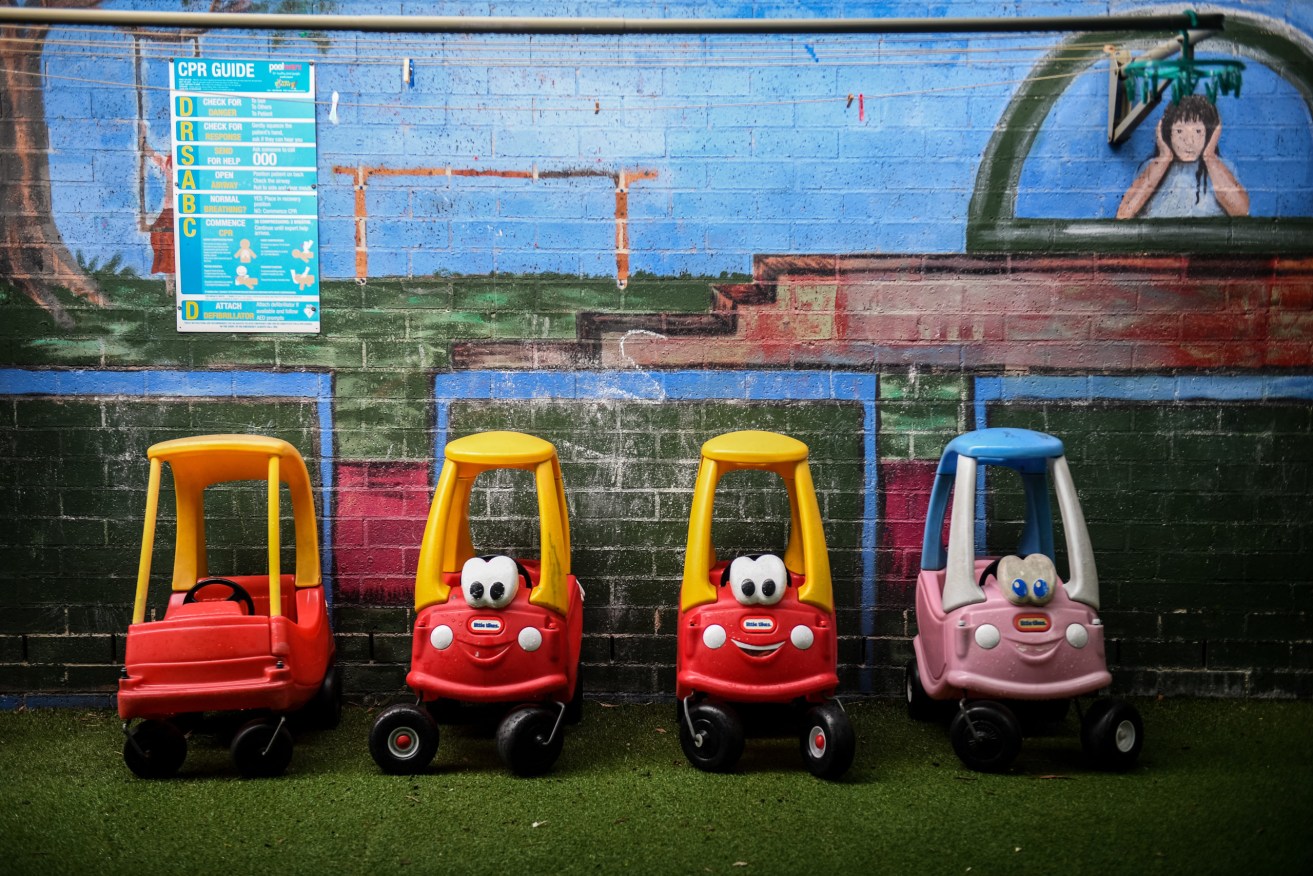SA childcare industry braces for the next twist on the rollercoaster
Like every sector of the South Australian economy, the state’s childcare centres have been on a difficult and twisting journey this year. Here’s how they see the months ahead playing out as government policy again takes a sharp turn.


Photo: AAP/Brendan Esposito
Free childcare ends next month and the state’s childcare centres are also first in the queue to lose their JobKeeper lifeline.
As the state’s 350 childcare centres prepare yet another new operating plan, the sector is holding its collective breath to see if the latest COVID-19 changes trigger an exodus of children from the system.
“All of us are a bit nervous about how many children we will lose,” Kerry Mahony, the president of the state’s Australian Childcare Alliance, said.
“And all of us are nervous about a second wave of the virus and what that might do to the industry.”
It has been a rocky path for the childcare sector after COVID-19 saw the number of children enrolled at centres each day plummet in March. In April, the industry was on the verge of collapse.
“In the last week of March, families just left us en masse, almost like a panic evacuation,” Mahony said.
Industry leaders and governments scrambled to pull together a survival package.
A 50 per cent subsidy for centres emerged from the meetings, along with free childcare and JobKeeper payments.
So far, the package has saved most centres – but Mahony says the chaos created by families pulling children from centres comes at a high cost.
Many operators have been forced to take out bank loans to pay staff and to throw important maintenance and other operations onto the backburner.
“It was a survival package and it has helped us survive but there is a gap and that gap has to be filled by our own resources,” Mahony said.
Mahony owns two childcare centres in Adelaide and employs about 40 staff, while his alliance represents 100 privately-owned centres in South Australia.
“I’ve borrowed money to pay wages,” he said.
Now, despite a wider lobby for free childcare to stay in place, most industry leaders are welcoming the regime getting back to normal.
Mahony thinks it is time to rip off the early economic bandaid.
In particular, his organisation is welcoming the Federal Government’s commitment to swap the JobKeeper payments for a transition fee paid directly to centres.
This equates to 25 per cent of a centre’s usual running costs calculated on February figures and will cover from July 13 until September 27 – with centres having to guarantee employment levels are maintained.
Families are also being ensured up to 100 hours of subsidised care a fortnight through the Federal Government’s Child Care Subsidy.
Mahony said the changes mean the industry can move on from survival mode.
“I think childcare centre operators are feeling a great relief that they can see the way clear to going back to normal fees and a transition payment,” he said.
“I talk to a lot of childcare operators both here and nationally and the feeling is good about the future.”
But not everyone is happy.
Federal Labor has criticised the moves to finish JobKeeper payments for childcare workers on July 20 and end the free childcare program July 12.
“When the Treasurer has admitted Australia is in a recession and many families are struggling to make ends meet, this government has decided now is a good time to bring back high child care fees,” Labor’s spokeswoman for early childhood education and development, Amanda Rishworth, said in a statement.
“Families were already being hammered by high fees before the pandemic.
“Now when parents are earning less or have lost their jobs, this snap back will make early education and care completely unaffordable and inaccessible for many.”
Rishworth said anecdotal evidence shows the change will lead to falling demand.
“Families simply can’t afford fees and some estimates have been that 25 – 35 per cent of families could well drop hours or leave care altogether,” she said.
But Mahony says centres are haemorrhaging under the current system where there are hurdles stopping them from operating at capacity.
“There has been a strong campaign to maintain free childcare for parents. The concept sounds lovely but bear in mind the new structure coming back into place costs about $8 billion in Federal Government funding, that is paid for by the taxpayer,” he said.
“Free childcare across the board, that would jump to $24 billion – it’s three times more. I don’t think Australian taxpayers are ready to pay that.”
The transition payment also gives centres greater control over their staffing levels, Mahony argues.
Childcare runs under a complex regime of ratios – one staff member for four babies, one staff member for five children aged two to three years and one staff member for 10 three to five-year-olds.
Then there are overlapping shifts for centres opening 12 hours and staff lunch breaks to consider.
The unpredictability of child numbers with COVID-19 has made staff rostering difficult.
JobKeeper adds another layer of juggling with a disparity between full-time, part-time and casual employees working varied hours but all being paid the same $1500 a fortnight under JobKeeper.
Many casual staff members suddenly landed significant pay rises with fewer rostered hours.
The alliance’s national president, Paul Mondo, said the early relief package was a lifeline “at a time when our centres were on the verge of collapse”.
“However, as the COVID crisis is reined in and more and more children are returned to their early learning centre, the relief package is no longer working for services and families,” he said.
He said the new transition payment instead went directly to centres so they could manage staff salaries and child numbers with greater discretion.
“The transition payment ensures the survival of service providers as we navigate through a period of economic uncertainty while offering up to 100 hours of subsidised care each fortnight for our families whose employment has been negatively impacted by COVID-19,” he said.
“(But) it is obviously very difficult to predict the attendance outcomes of the weeks ahead, let alone months ahead at this point in time with so many possible variables in the current climate.”
Like most sectors, it is now a matter of wait and see.
Want to comment?
Send us an email, making it clear which story you’re commenting on and including your full name (required for publication) and phone number (only for verification purposes). Please put “Reader views” in the subject.
We’ll publish the best comments in a regular “Reader Views” post. Your comments can be brief, or we can accept up to 350 words, or thereabouts.
This article is supported by the Judith Neilson Institute for Journalism and Ideas.





